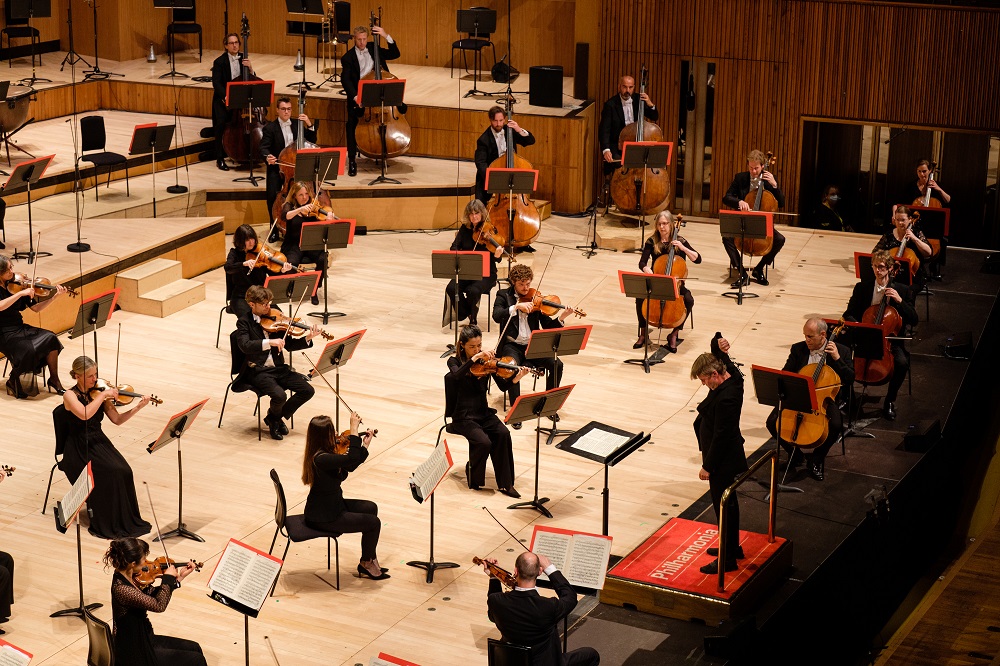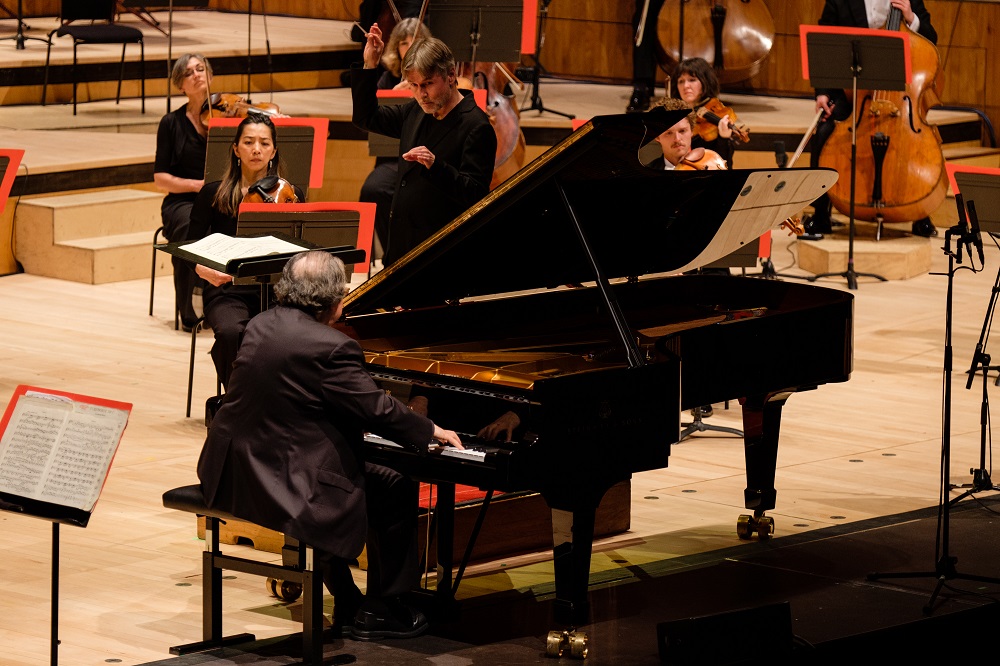Bronfman, Philharmonia, Salonen, RFH review – celebration around C major | reviews, news & interviews
Bronfman, Philharmonia, Salonen, RFH review – celebration around C major
Bronfman, Philharmonia, Salonen, RFH review – celebration around C major
The brilliant first of a great principal conductor’s two farewell programmes

One of the many things we’ll miss when Esa-Pekka Salonen moves on from his 13 years as the Philharmonia’s principal conductor will be his programming. For this first of his farewell concerts, he’s not only chosen what he loves but made sure it all fits.
Most important of all, an audience is back in the Royal Festival Hall to greet the Philharmonia players with what Simon Rattle the other week called “that noise you make with your hands” as well as loud cheers and a standing ovation. Well deserved; the sheer beauty and spaciousness of the orchestral sound from the spread-out orchestra on the helpfully extended platform, resonating in a hall with fewer people in than usual due to the necessary Covid restrictions, needed our presence there to witness what, more than ever after a year of semi-silence, felt like a miracle. And look, none of the fidgety lighting and smoke which have marred the LPO's livestreams from the same hall. Choose a colour on the magnificently restored organ, stick with it for at least a movement, make sure the players and conductor are in full light, and that's all you need. The Beethoven performance (pictured above) had all the virtue of chamber-orchestra crispness – and vivid period timpani – enriched by resonant ballast from five double-basses. Salonen seemed genial but always alert, and the beauty of his conducting technique was a joy in itself in the figures he made with the baton hand as the violins airily elaborate the wind pulsing of the scherzo’s trio. Those humorous attempts to make a complete scale from G in the finale’s opening Adagio were managed with supernatural skill, and the watchful interplay between second violinist Annabelle Meare and leader Zsolt-Tihamér Visontay told us, as the sounds already had, what sheer joy there was in being back and playing together.
The Beethoven performance (pictured above) had all the virtue of chamber-orchestra crispness – and vivid period timpani – enriched by resonant ballast from five double-basses. Salonen seemed genial but always alert, and the beauty of his conducting technique was a joy in itself in the figures he made with the baton hand as the violins airily elaborate the wind pulsing of the scherzo’s trio. Those humorous attempts to make a complete scale from G in the finale’s opening Adagio were managed with supernatural skill, and the watchful interplay between second violinist Annabelle Meare and leader Zsolt-Tihamér Visontay told us, as the sounds already had, what sheer joy there was in being back and playing together.
Bronfman (pictured below with Salonen) is a master who can roar like a lion – in the case of the Liszt Concerto, a rather comical one prefiguring the proud beast of Saint-Saëns’ Carnival of the Animals – and coo like any sucking dove in transcendental reverie. It doesn’t matter that swathes of this work make us laugh now with their romantic excess; there’s joy there too. Yet never as much deep poetry, despite the interesting chord sequences, as in the Schumann Arabeske; Bronfman made the contrasting episodes troubled, the main sequences objectively beautiful, the coda exquisite.  If the Beethoven was revelatory, Stravinsky’s Symphonies of Wind Instruments proved even more so in this astounding performance. Having the ensemble spread the whole width of the extended platform, horns to the left answering trombones and tuba to the right, gave extra frissons, but the real mastery was in how Salonen dovetailed the various “soundings-together” (sym-phonies) to create an almost operatic, certainly very vocal set of dialogues, until the hieratic slow conclusion (in memory of Debussy), moving to tears.
If the Beethoven was revelatory, Stravinsky’s Symphonies of Wind Instruments proved even more so in this astounding performance. Having the ensemble spread the whole width of the extended platform, horns to the left answering trombones and tuba to the right, gave extra frissons, but the real mastery was in how Salonen dovetailed the various “soundings-together” (sym-phonies) to create an almost operatic, certainly very vocal set of dialogues, until the hieratic slow conclusion (in memory of Debussy), moving to tears.
Salonen’s approach to the symphonies of his most famous compatriot Sibelius has always, for me, been hit and miss: grandiose compared to the lighter touch and freer flow of other Finnish interpreters like Sakari Oramo, Jukka-Pekka Saraste and Okko Kamu. This Seventh was more evocative of the Grand Canyon than of northern forests and lakes – and we tend to be right at the bottom, grateful to catch glimpses of the sky. But that’s how he sees and hears it, and you couldn’t argue with the masterly transitions, the superb solo trombone which anchors the piece (Byron Fulcher), the gilded edge of horns or – once again – those heartfelt strings. For the concert as a whole, the standing ovation was, I repeat, well deserved.
- Listen to this concert for the next month on the BBC Radio 3 iPlayer
- This concert will be streamed on Thursday 24 June. Second concert, with Mitsuko Uchida, takes place on Thursday 10 June (sold out), further details here
- More classical music reviews on theartsdesk
rating
Share this article
Add comment
The future of Arts Journalism
You can stop theartsdesk.com closing!
We urgently need financing to survive. Our fundraising drive has thus far raised £49,000 but we need to reach £100,000 or we will be forced to close. Please contribute here: https://gofund.me/c3f6033d
And if you can forward this information to anyone who might assist, we’d be grateful.

Subscribe to theartsdesk.com
Thank you for continuing to read our work on theartsdesk.com. For unlimited access to every article in its entirety, including our archive of more than 15,000 pieces, we're asking for £5 per month or £40 per year. We feel it's a very good deal, and hope you do too.
To take a subscription now simply click here.
And if you're looking for that extra gift for a friend or family member, why not treat them to a theartsdesk.com gift subscription?
more Classical music
 Anja Mittermüller, Richard Fu, Wigmore Hall review - a glorious hall debut
The Austrian mezzo shines - at the age of 22
Anja Mittermüller, Richard Fu, Wigmore Hall review - a glorious hall debut
The Austrian mezzo shines - at the age of 22
 First Person: clarinettist Oliver Pashley on the new horizons of The Hermes Experiment's latest album
Compositions by members of this unusual quartet feature for the first time
First Person: clarinettist Oliver Pashley on the new horizons of The Hermes Experiment's latest album
Compositions by members of this unusual quartet feature for the first time
 Gesualdo Passione, Les Arts Florissants, Amala Dior Company, Barbican review - inspired collaboration excavates the music's humanity
At times it was like watching an anarchic religious procession
Gesualdo Passione, Les Arts Florissants, Amala Dior Company, Barbican review - inspired collaboration excavates the music's humanity
At times it was like watching an anarchic religious procession
 Classical CDs: Camels, concrete and cabaret
An influential American composer's 90th birthday box, plus British piano concertos and a father-and-son duo
Classical CDs: Camels, concrete and cabaret
An influential American composer's 90th birthday box, plus British piano concertos and a father-and-son duo
 Cockerham, Manchester Camerata, Sheen, Martin Harris Centre, Manchester review - re-enacting the dawn of modernism
Two UK premieres added to three miniatures from a seminal event of January 1914
Cockerham, Manchester Camerata, Sheen, Martin Harris Centre, Manchester review - re-enacting the dawn of modernism
Two UK premieres added to three miniatures from a seminal event of January 1914
 Kempf, Brno Philharmonic, Davies, Bridgewater Hall, Manchester review - European tradition meets American jazz
Bouncing Czechs enjoy their Gershwin and Brubeck alongside Janáček and Dvořák
Kempf, Brno Philharmonic, Davies, Bridgewater Hall, Manchester review - European tradition meets American jazz
Bouncing Czechs enjoy their Gershwin and Brubeck alongside Janáček and Dvořák
 Solomon, OAE, Butt, QEH review - daft Biblical whitewashing with great choruses
Even a top soprano and mezzo can’t make this Handel paean wholly convincing
Solomon, OAE, Butt, QEH review - daft Biblical whitewashing with great choruses
Even a top soprano and mezzo can’t make this Handel paean wholly convincing
 Two-Piano Gala, Kings Place review - shining constellations
London Piano Festival curators and illustrious friends entertain and enlighten
Two-Piano Gala, Kings Place review - shining constellations
London Piano Festival curators and illustrious friends entertain and enlighten
 Echo Vocal Ensemble, Latto, Union Chapel review - eclectic choral programme garlanded with dance
Beautiful singing at the heart of an imaginative and stylistically varied concert
Echo Vocal Ensemble, Latto, Union Chapel review - eclectic choral programme garlanded with dance
Beautiful singing at the heart of an imaginative and stylistically varied concert
 Scott, Irish Baroque Orchestra, Whelan, RIAM, Dublin review - towards a Mozart masterpiece
Characteristic joy and enlightenment from this team, but a valveless horn brings problems
Scott, Irish Baroque Orchestra, Whelan, RIAM, Dublin review - towards a Mozart masterpiece
Characteristic joy and enlightenment from this team, but a valveless horn brings problems
 Classical CDs: Voice flutes, flugelhorns and froth
Baroque sonatas, English orchestral music and an emotionally-charged vocal recital
Classical CDs: Voice flutes, flugelhorns and froth
Baroque sonatas, English orchestral music and an emotionally-charged vocal recital

Comments
Thank you for this brilliant
It's so good to hear from a
It's so good to hear from a player - thank you for taking the trouble. I think we realise more than ever what a two-way thing it is between performers and audience. At times last night I was even struck by the miracle of togetherness. So deepest gratitude to you all, too.